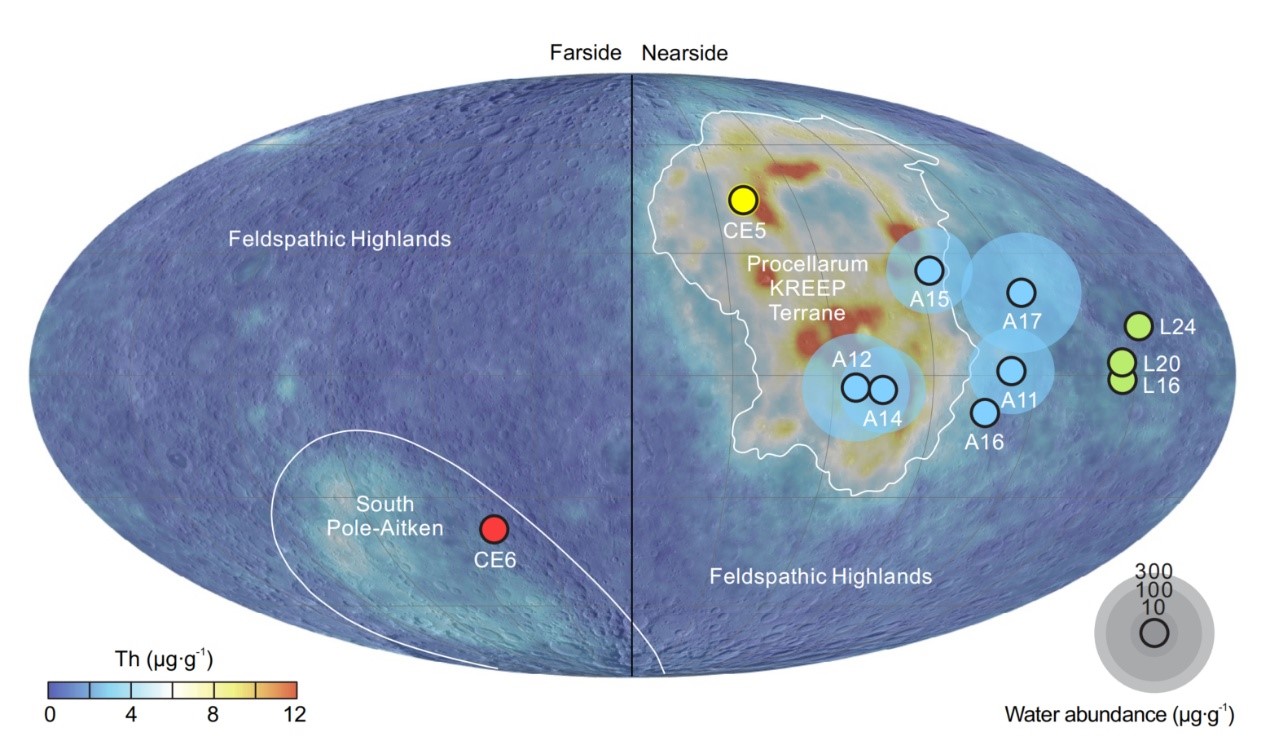The water content of the lunar interior provides critical insights into the Moon's formation and subsequent thermochemical evolution. A research team led by Prof. HU Sen at IGGCAS, analyzed lunar basalts collected by the Chang'e-6 mission (CE6). Their study estimates a water content of 1–1.5 μg.g-1 for the mantle source of CE6 mare basalts, suggesting that the lunar farside mantle may be drier than its nearside counterpart. These findings were published in Nature.
Over the past two decades, significant advances have reshaped our understanding of water in the lunar mantle, shifting from the traditional "bone dry" model to a relatively "wet" Moon. Extensive analysis of lunar samples from the nearside have revealed a highly heterogeneous water distribution in the lunar interior, with abundances ranging from ~1 to 200 μg.g-1. Notably, the crust exposed at the surface of the Procellarum KREEP Terrane exhibits a higher thorium (Th) concentration than the other two primary lunar geochemical provinces: the Feldspathic Highlands and the South Pole–Aitken (SPA) Basin. Both Th and water behave as incompatible elements in magmatic processes, preferentially remaining in the melt rather than incorporating into solidifying minerals. This geochemical behavior suggests that the lunar mantle beneath the SPA Basin may contain lower water content. If confirmed, this possibility would provide crucial constraints on the spatial and temporal distribution of water in the Moon’s mantle, as well as on models of its giant-impact formation and subsequent magmatic evolution.
Under the guidance of Prof. HU Sen, HUI Hejiu, and LIN Yangting, postdoctoral researcher HE Huicun and PhD student LI Linxi analyzed water contents and hydrogen isotopes in melt inclusions and apatite within CE6 mare basalts—the first samples returned from the Moon's farside SPA basin. Their analysis estimates the parent magma of CE6 mare basalt to have contained 15–168 μg.g-1 of water. Furthermore, the mantle source of these basalts is estimated to have a water abundance of 1–1.5 μg.g-1, indicating that the farside mantle is potentially drier than that of the nearside. This contrast suggests that water distribution in the Moon’s interior may exhibit a hemispheric dichotomy, similar to many observed surface features. The new estimate for the lunar farside mantle represents a significant step in refining estimates of the bulk silicate Moon's water content, offering key constraints on the giant-impact origin hypothesis and the role of water in in the Moon's long-term evolution.
This research was conducted in collaboration with Nanjing University.
This study was supported by the National Natural Science Foundation of China (42125303 and 42241104), the Strategic Priority Research Program of the Chinese Academy of Sciences (XDB 41000000), the China National Postdoctoral Program for Innovative Talents (BX20240365), and the Key Research Program of the Institute of Geology and Geophysics, Chinese Academy of Sciences (IGGCAS-202401 and 202204). The CE6 samples were allocated by the China National Space Administration (CNSA).

Figure: Lunar sample return sample missions with associated water content estimates. (Image by Prof. HU Sen's research group)
Contact:
HU Sen
Center for Earth and Planetary Physics
Institute of Geology and Geophysics, Chinese Academy of Sciences
Phone: 010-82998086
E-mail: husen@mail.iggcas.ac.cn